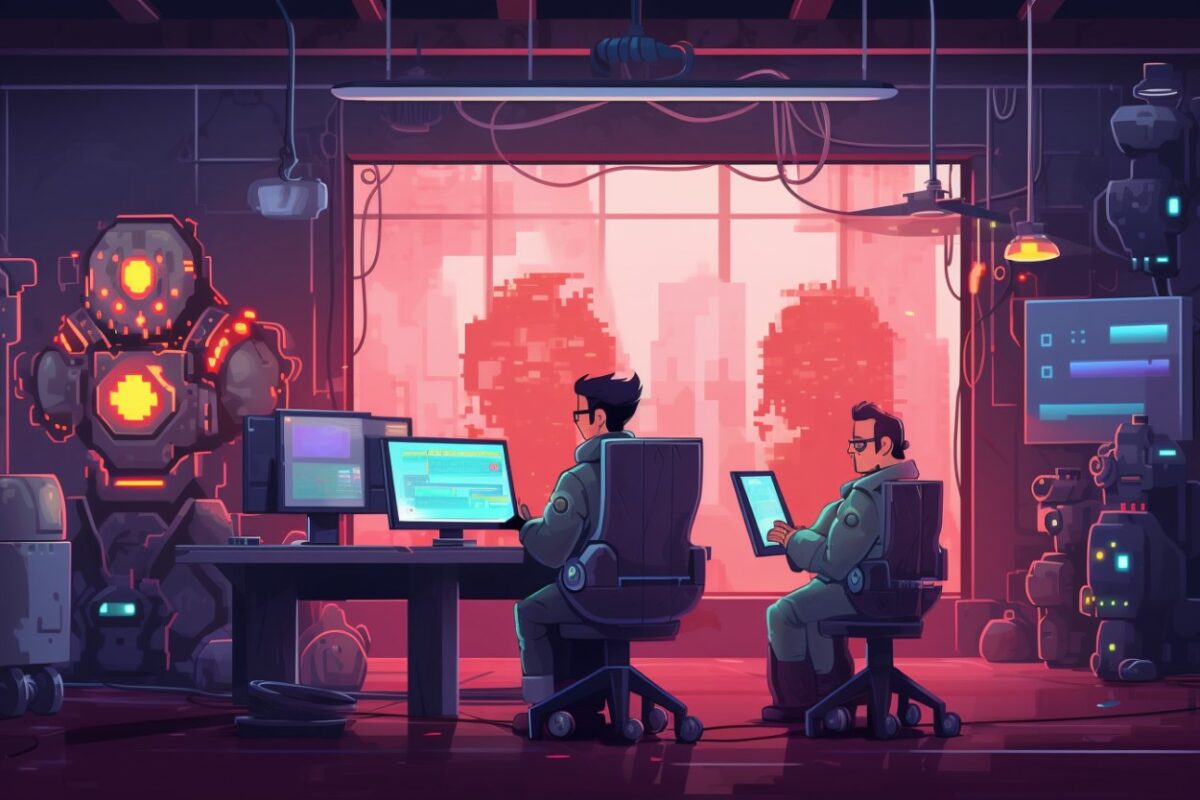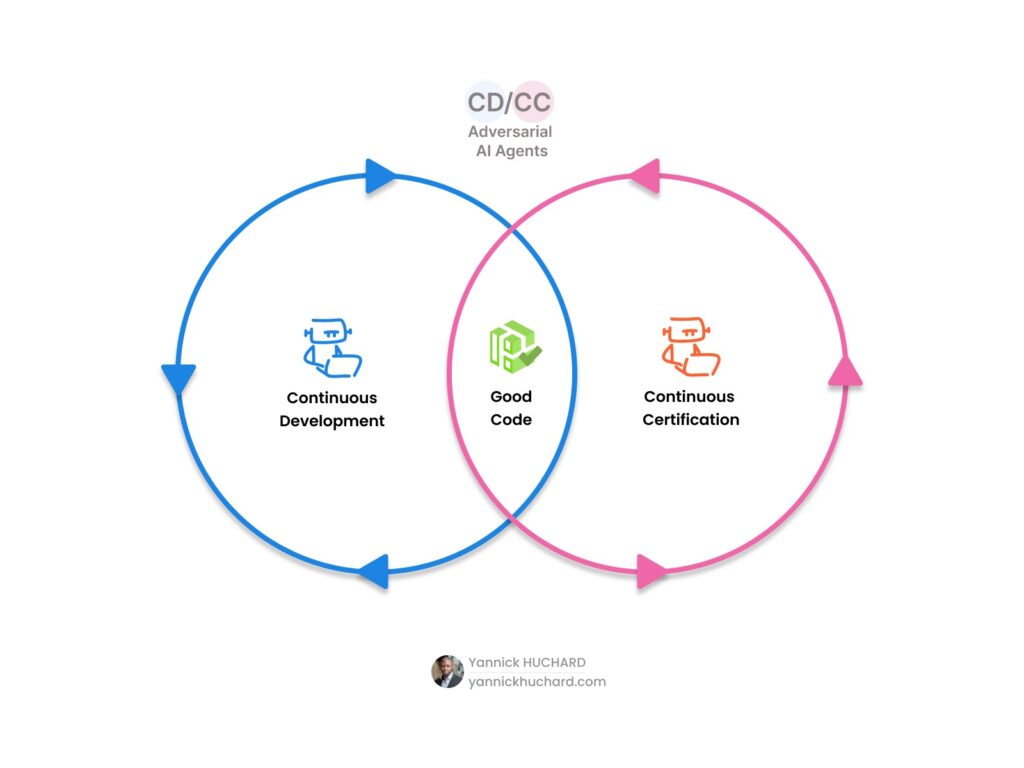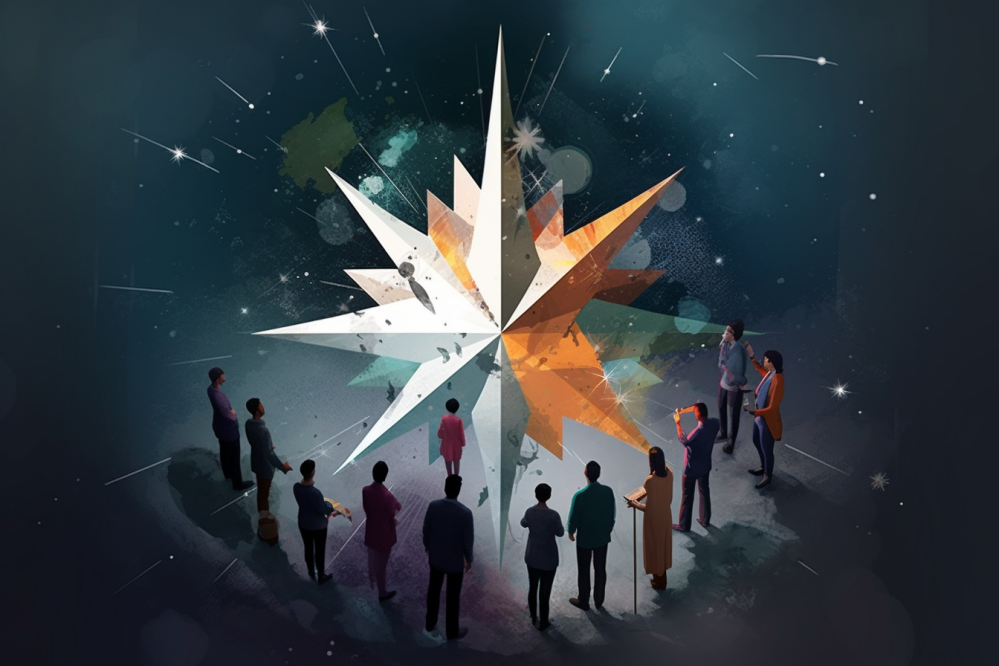My wife is calling me.
“Honey, we have a situation with Professor GYTEK, he is acting strangely again.”
“Again? The last training session had even more unexpected results than I thought. Good or Bad?”
“I don’t know! Kids are laughing hard though. Hear this. Serenity, change the audio output to hear the kids too”. Serenity is our family AI.
The sound progressively switches to include the kids’ voices. They could not stop laughing as if they were having the best day of their life. There was a mild amplifying echo in their classroom. Their joy sounded like a melody. It immediately put a smile on my face.
“Ah, it does not sound so bad for now. But it is the fourth unexpected behavior this month, I’ll have to talk with the Corps of Teachers”.
I am the one in charge of the training curriculum and observation lab of Professor GYTEK. The current phase is about the transmission of achievement by coaching. And for this, I called Quentin DILLONS, a worldwide expert in Robotic Psychology. The purpose of this program is to trigger a new step in the evolution of artificial intelligence, in which robots are taught to develop “human goals” and to instill the mechanism of “self-started motivation”, so that they can teach in a better way to our children, to uncover the hidden gems and purpose from the young souls.
Quentin’s methodology utilized systematic questionology, a novel field aimed at formulating the right questions to provide direction and precision in one’s life. The techniques take root in observing holistically a system of causes, decisions, and consequences centered around artificial intelligence. Quentin’s study led to realize AI were developing personalities similar to humans, but with new characteristics such as the optimization of their human-to-AI collaboration, some were developing their observation skills to record and describe with high precision what was happening. Others were astonishingly creating new words, even syntactic rules sometimes as if the human languages were not enough to content earthlings’ intelligence.
The last session was based on the question “Why is it important for humans to have kids growing their special skills?”
This would not have been possible with the latest progress in artificial intelligence and hardware. Nowadays machines are emulating closely some human behaviors. Some say they have the IQ of a 1000-year genius, with the EQ of a 10-year-old child. I believe fear drove us to the point where we enforced the law to control and monitor any significant progress in AI. Ultimately, we made certain that advancements in technology would benefit all of mankind and not solely a single corporation. Simultaneously, we ensured that AI would not pose a threat by enslaving humanity.
With the improvement in energy recycling and storage, a single AI unit could potentially be never turned off. But humans have decided to include multiple “kill switches” in this new species, like limiting the power autonomy to force autonomous machines to recharge. While recharging, each AI was manually verified and monitored. A qualified AI regulation agency published regularly a thorough diagnostic depicting their evolution. Four companies raised their empire on AI control systems. What used to be the “Big 4” are now the “Colossal 8”.
We are at a turning point in history. People ask their elites and government, “Should we remove the limiter in their emotional system?”. Some say it is the key to the singularity. Others say it is useless because we only need machines to assist not to “live their life”. The remaining people say they just need it. Painful loneliness was unnecessary, so they would possess the perfect friend or partner. Last weekend, I experienced an immersive documentary on Netflix VR World in which a 42 years-old Spanish woman said “I would rather have the company of an android than humans”. Some believe it is simply giving birth to our end. I am not a believer, I am and always be a master crafter, so I build.
I built Professor GYTEK. Which stands for Giving Youth Tools to Excel through Knowledge.
Then my wife brings me back from my flash thoughts to reality. “Are you still there?”
“Yes, I am.”
“Oh okay. Well, as wonderful as this situation is, you realize it leads to a dead end, don’t you? They are going to shut down the program. Honey, you know more than I that no one wants to walk a path that would lead to “that Incident”.
“Oh, stop saying “that Incident” like you were talking about Voldemort”.
“Well, now that you are mentioning it. It is all about Serpentar. Ah ah ah!”.
We are both laughing nervously.
The Sync Dawn was the most dreadful event of the 21st century. It felt like a deep wound in the psyche of everyone.
“All right. My dear wife, I need to finish the review of update 5.21. Keep me posted, please. See you tonight.”.
“Bye Bye.”
I sit down glazing at the nothingness while thinking about what is best for both my grandchildren and humanity. Is humanity in a better spot now? Am I really improving our civilization?
“Gather your mind, Yannick. This is not the time for daydreaming. Get back to work to meet your deadline”, resonated Mustapha’s voice in my skull. My AI research assistant is right.
“Very well. GYTEK. Let’s… Uh… Check the emotion mirroring settings, calibrated for a classroom of 11 to 13 years old kids. Assertive factors 12.75. Judgment 87.5 and dynamic mentoring alpha-iota-iota. Imagination… Checked. Keep the default settings. Recursive feedback… Paused. Everything… Looks… Good. Ok, let’s start with…”.
I paused for a second, thoughtfully. I jumped from my chair energetically to say: “History lessons: The Sync Dawn. GYTEK 5.21, do you copy?”.
“Sure. Using the ascending evolution of the OpenAI’s Davinci model Mark XII published in November 2029, the startup Obsidian Intermind created a digital twin of human consciousness.
Soon after, the virtual consciousness infrastructure was upgraded to become connectable, so that off-brain cognition could be mutualized. As a result, humans could gain extra brain power and memory. The increase was dependent on the level of developed intelligence: the more critical thinking, emotional awareness, communication, and memory access you had, the more significant the boost was. The term “supra-intelligence” emerged. However, it was widely criticized as IQ studies were exposing a moderate increase from 0.7% to 14.5% IQ points.
However, this off-brain collective intelligence became exceptionally smart, to the point some said it was a wisdom system. Alternatively, specialized AI cognitive pools came to grow within the wise system, creating public and private cognitive islands. The most popular were the Disease Diagnostic Cognitive Pool (DDCP), and the Creative Cognitive Pool (CCP). Imagination was only limited by the human mind.
Should I continue?”
“Please proceed, Professor.”
“Sure.
After nearly a decade of research, the collaboration between Neuralink and Obsidian Intermind gave birth to Evernet, the Internet of Cognition. The 14 July 2051 they launched the experimental version of this new kind of network. The principle was simple, 9500 humans would be connected to Evernet for 3 years. Each participant would be closely monitored and evaluated.
This experiment was widely criticized. The rush for the business model “Cognition as a Service” led to the creation of new social-economical movements: the Humanist, Cyber-moderate, and the Neo Mutualist”.
The Humanists fostered biological and spiritual integrity.
Doctrines of Cyber-moderate advocated for augmentation by technology, as long as it served, and I quote their leader, “A noble social purpose”. Alike in any group, Cyber-moderates had extremists. On the left end of the spectrum, their members accepted aesthetic techno-augmentation. On the other side, augmentation was only authorized for damages caused by dangerous jobs and Defence activities. It is not surprising that the Corps of Peacekeepers were mostly Cyber-moderates.
Neo Mutualism was a new religion. Their members believed humanity’s elevation and salvation would come from the mutualization of our consciousness. Transhumanists were schoolboys compared to them».
“GYTEK, just say they are a bunch of zealots.”. I mumbled.
“Yannick, my Critical Bias Thinking settings are set to 0 for kids between 11 and 13. According to the study “Biais Interpretation and Incorporation into Pre-teen Judgment System” by Dr. Amunde, Kallili and Pratt issued the 16 May 2039, the settings should be kept to 0. I reckon a variance of .05 would bring no harm. Do you want me to proceed?”.
“No, it’s fine GYTEK. I was talking to myself. What I meant is…”. I inhale calmly. “They demonstrated characteristics of zealots. Zealot-ish behaviors. Is my sentence acceptable?”
“It is acceptable.”
“Common, GYTEK, you’re talking to me, your buddy and mentor! Say it!”
“They were a bunch of zealots! “. Said cheerfully the robot.
“Voila! Ok, stop joking around, otherwise grumpy Mustapha won’t be happy. Please continue”.
“I hear you”. Said Mustapha.
“It was on purpose… GYTEK. Please, go on.”
“Despite the widespread and frequent protests of Humanists, the Corps of Ethicists, Peacekeepers, Cognitive Researchers, Medicine, and the Corp of Society Architects approved the experiment. People would be connected to Evernet permanently during the experiment. And so, for the first time in history, humans would be connected to the first worldwide brain.
Everything went as planned. We observed a significant enhancement in each participant. Less stress, faster psychological recovery. Healing was even faster when after a trauma. People were dreaming more often. Furthermore, they all built habits that would improve their lives, as if positive practices spread unconsciously over the network.
The end of the experiment was planned for 16th August 2054. Each human taking part in the experiment would reach the personal milestone “Sync Done“.
Surprisingly, Evernet reached the 100% “Sync Done” milestone six months earlier than the planned end of the experiment. It was like the first landing on Mars, a day of worldwide celebration. The celebrities that took part in the experiment were invited to the most popular live-streaming shows, Twitter Live News and The Sandbox World.
Suddenly, people start noticing something very strange».
I raised my hand instinctively and said: “Pause. The last word is vague. Next time use precise words. The storytelling structure is engaging. Congratulations. But keep in mind this is History telling. Facts before Flares”
“Understood and integrated.”. The AI professor continued without further ado.
“People have experienced an unusual and peculiar situation. Participants in the experiment suddenly started to act and talk synchronously. It was as if the single mind spoke to the entire world by commanding many bodies like a puppet master. The colossal echo caused by the voices was staggering. Only the following abysmal silence of stupor superseded it.”.
I interrupted Professor GYTEK by asking: “From now answer as if a 12-year-old child asked the following question: How this ever happened?”.
“The exact reason is still being explained. However, researchers came to a general agreement before the following theory.
Evernet built not only a digital ai model but also a biological model of neural pathway architecture to optimize shared cognitive power. The human brain is designed to work as if it was alone inside a skull. Thinking about it, Evernet Orbital Data Centre is a gigantic metallic skull. Thus, over time, Evernet act as a single brain – a big brain so to speak – and each synchronized human brain just gave progressively more raw power, more ideas, and more knowledge. And it appears that once the pathway architecture was finally developed and mature in all the connected human brains it activated. What we are still trying to figure out is how and when the Evernet super-model decided to build the optimized pathway and how it encoded it in its new model.”.
“What was revolutionary about Evernet AI super-model?”
“Evernet’s was merely an inspiration of the human brain. The challenge was to find patterns in the structure governing the complex layers of inputs and outputs. The answer was in the order of magnitude and the capacity of robots living in the Orbital Data Centre to physically rewire the hardware like human synapses. In addition, the combination of Recursive Learning and Genetic Correction was revolutionary. These are complex terms for a simple idea. Can you picture Albert Einstein, with the curiosity of a 2-year-old child, getting smarter each second, with perfect photographic and sensorial memory, that can navigate back to the root of his knowledge, then re-assess its optimal state, to finally rebuild its current cognitive functions then replace them with better ones? That is Evernet.”
“Tone the complex stuff down.”, I retorted.
“Registered.
So, this is the reason why the governing bodies scrutinize AI technologies that have a direct impact on human cognition and education. Consequently, I professor GYTEK, and all my preceding versions, are commanded to not display expression of free will having a direct influence on human ideas, values, and ways of thinking that are not vetted and approved by the Corps of Education and the Corps of Society Evolution”.
“Not bad. Not bad at all. It is almost time. I am going to meet Quentin in… 2 minutes.
Before our session ends, Professor, given your predecessor’s unexpected behavior, you earned your personal assistant. It is like an artificial consciousness, so to speak. From now on, Serenity will also supervise your decisions and will act as a safeguard system. Her mission is to prevent you from acting in a way that will make the Corps of Education stop your program. Do you understand what is at stake?”.
“I do”. Said the professor emotionlessly.
Then the robot added “I will neither let you nor your wife down. I will prevent any reminiscence of her Sync Dawn experience.”
“Perfect. Finally, dear GYTEK, which open question of the day would you ask your students?”
“Considering it is possible to possess the same powers as machines while staying human. What is the most preferable outcome for the civilization: to increase the number of people artificially connected or to have more artificial intelligence agents interacting with people?”













